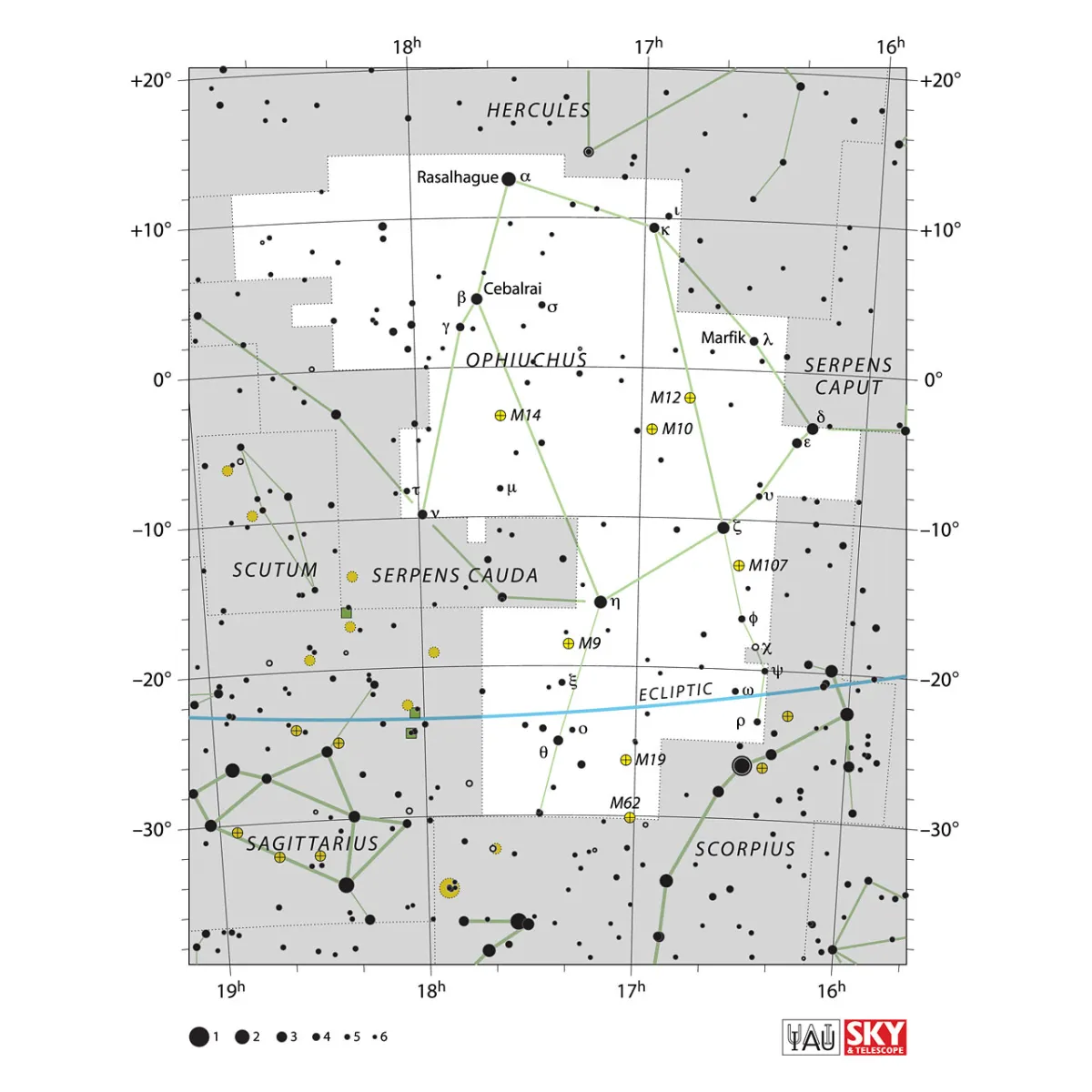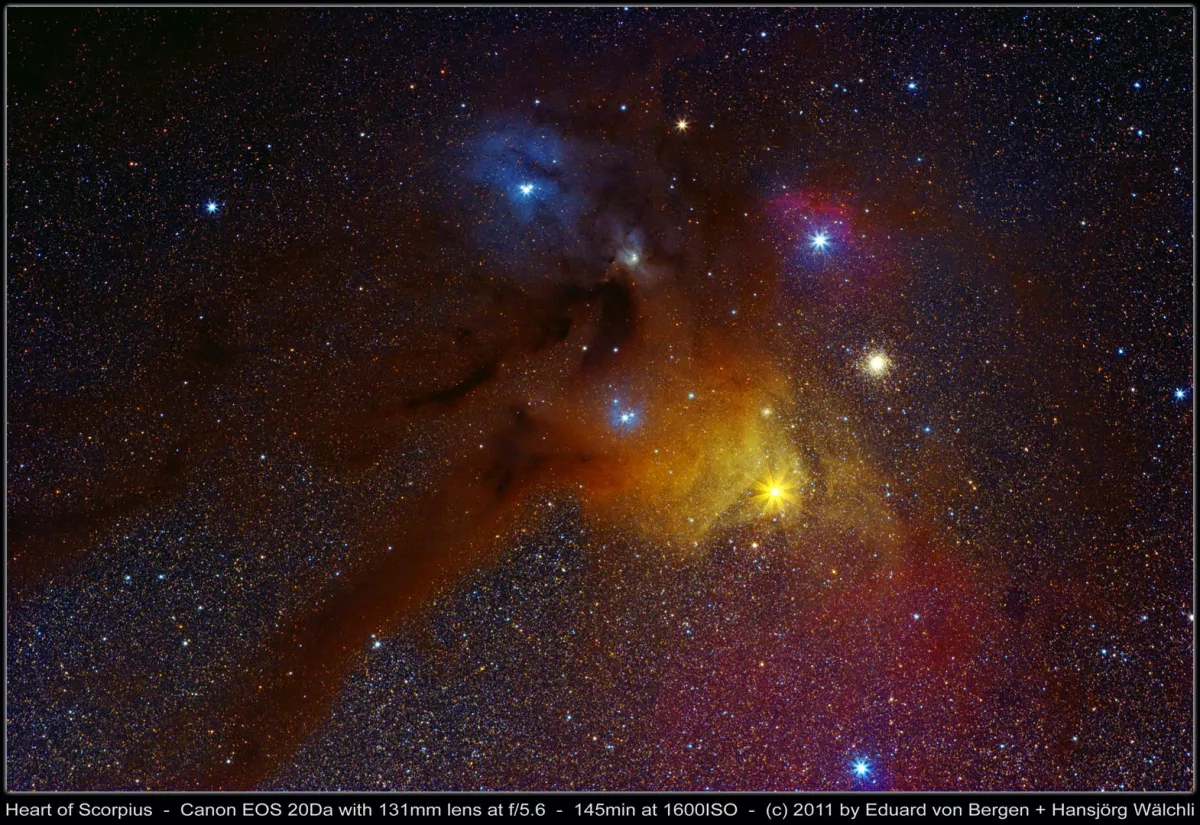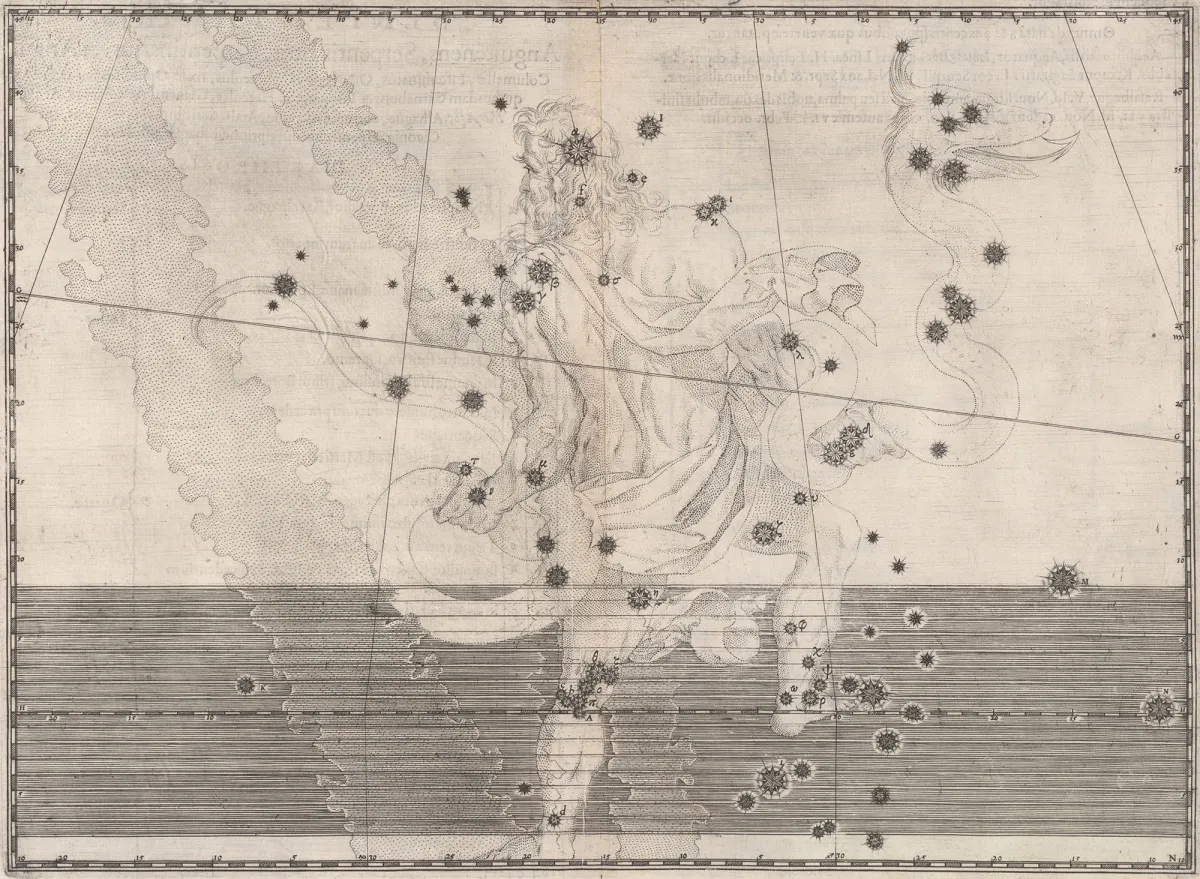Constellation Ophiuchus (Serpent Bearer)

Properties
Ophiuchus is a large but not very impressive constellation with 948 square degrees and lies between Hercules north and Scorpius south of it. The constellation divides the constellation Serpens into a western part with the head (Serpentis Caput) and the eastern part with the tail of the serpent (Serpentis Cauda). On a dark night, with a little imagination, you can see a great man in the stars like a two-year-old would draw it. The constellation is known for its large number of globular clusters, as the southern part lies in the band of the Milky Way and close to its centre. The centre of the constellation culminates around midnight on June 11th. [9, 15]
| α Oph | Rasalhague, Ras Alhague |
| β Oph | Cebalrai, Kelb Alrai, Kabalrai, Cheleb, Celb-Al-Rai |
| δ Oph | Yed Prior, Yad, Yed, Jed |
| ε Oph | Yed Posterior |
| η Oph | Sabik |
| λ Oph | Marfic, Marfik, Marsic |
| IAU Name | Ophiuchus |
| IAU Genitive | Ophiuchi |
| IAU Abbr. | Oph |
| English Name | Serpent Bearer |
| Culmination at local midnight | 10 June |
| Season (Latitude +0.0°) | February … November |
| Right Ascension (J2000.0) | 16h 01m 33s … 18h 45m 50s |
| Declination (J2000.0) | -30° 12' 44" … +14° 23' 15" |
| Area | 948 deg2 |
| Neighbours (N↻) | Her, Ser, Lib, Sco, Sgr, Aql |
Deep-Sky Object Descriptions
Barnard 72
IC 4604
Minkowski 2-9
NGC 6309
NGC 6369
NGC 6572
Catalogues
Mythology and History
The mighty serpent bearer is associated with Asklepios, the Greek god of healing. He was the son of Apollon with his lover, the beautiful Koronis from Larissa.

One day Apollon's raven observed the Koronis cheating with a youth from Thessaly and reported this to his master. Angry at his infidelity, Apollo picked up a bow and arrow and shot them. Koronis sank together with a sigh that he would now also lose his unborn child. Apollo now regretted what he had done. He saved the child, Asklepios, and brought him up to Chiron, a wise centaur.
Asclepius grew up in the care of the centaur Chiron and learned the art of healing from him. According to another version of this legend, he is said to have got his knowledge of medicinal herbs from a snake. Asklepios developed his healing art more and more and refined it more and more until he was finally so far advanced that he became a master of life and death. He had acquired the ability to bring the dead back to life. However, an oracle prophesied that if he dared to do so, he would be struck by Zeus' lightning. So Asklepios kept this art as his secret and was careful not to use it.
Hippolytus was the grandson of the sea god Poseidon. His stepmother Phaedra, the daughter of Poseidon's wife Pasiphae, tried to seduce him and desecrate his father's camp. But Hippolytus rejected them and so Phaedra slandered him to his father, who then cursed and disowned him. Hippolytus died shortly afterwards in an accident in his car when the horses were frightened by the sea monster. Asklepios happened to be there and regretted the unjust death of Hyppolytus. He brought it back to life. When Zeus found out about this, he hurled one of his bolts of lightning at Asclepius and killed him. But in order to honor him for his healing arts, he was accepted into Olympus and named the god of healing. Today he can still be seen in the sky with the snake. In many depictions the snake winds around his walking stick and is now the symbol of the medical professions. [20]

Asklepios had two daughters: Hygeia and Panacea. It is obvious how their names became familiar, health-related terms. Asklepios and his daughters have long been the patron saints of modern medicine. The "Hippocratic Oath" was named after Hippocrates, the Greek medic from antiquity (460-377 BC). This is often seen as the father of medicine. [102] The oath begins with the words: «I swear by Apollon the doctor and by Asklepios, Hygieia and Panakeia as well as invoking all gods and goddesses as witnesses that I take this oath to the best of my ability and in accordance with my judgment and will fulfill this contract.» [139]
According to another legend, Asklepios is said to have been the ship's doctor for the Argo Navis, who Jason and the Argonauts in search of the golden fleece of the Aries accompanied. Others suspect that the constellation Ophiuchus is Enkidu, the companion of Gilgamesh, who walks head to head across the sky with him in the form of Hercules. [7]
But there were also other interpretations, such as Laocoon, that Poseidon priest at Troy, who warned the Trojans not to trust the famous Trojan horse; but no sooner had he pronounced this warning than gigantic sea snakes came from the island of Tenedos, killing him and his two sons. [20]
The ancient Mesopotamians saw the sun god Marduk with the dragon Tiamat, the predecessor of the snake, in this constellation. [102]
The name Ophiuchus occurs in the earliest Greek astronomy and was also well known to the Romans. It is derived from the Greek word ophis (snake) and cheiro-o (handle). There are also some different spellings, such as Ophiulchus, Ophiultus and similar. According to the identification with Asklepios one finds Asclepios and Aesculapius. In Johann Bayers Uranometria from 1603 and in Johannes Hevelius Uranographia from 1690 one finds the name Serpentarius. [20, 28]